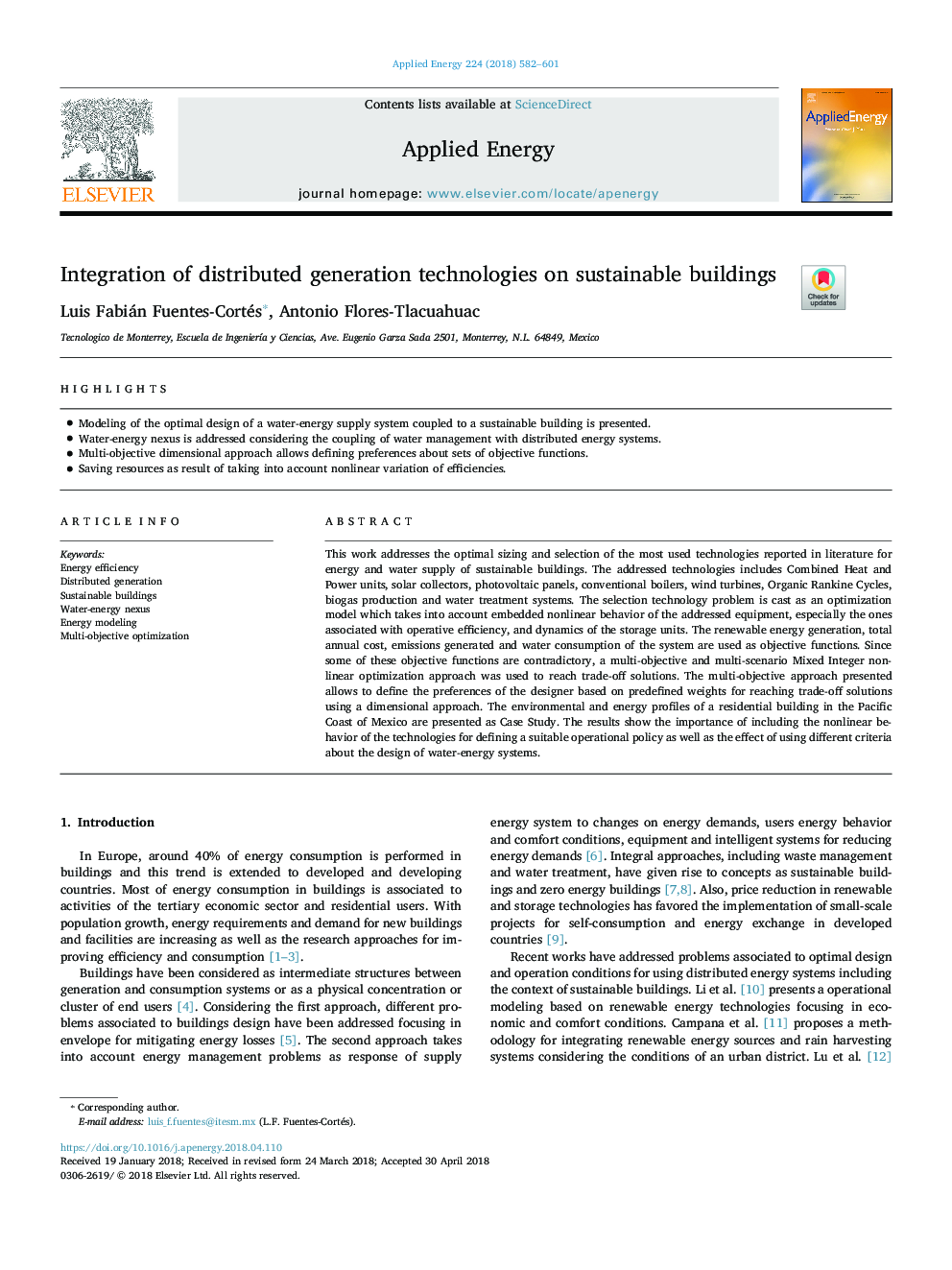| کد مقاله | کد نشریه | سال انتشار | مقاله انگلیسی | نسخه تمام متن |
|---|---|---|---|---|
| 6679977 | 1428066 | 2018 | 20 صفحه PDF | دانلود رایگان |
عنوان انگلیسی مقاله ISI
Integration of distributed generation technologies on sustainable buildings
ترجمه فارسی عنوان
ادغام تکنولوژی های تولید پراکنده در ساختمان های پایدار
دانلود مقاله + سفارش ترجمه
دانلود مقاله ISI انگلیسی
رایگان برای ایرانیان
کلمات کلیدی
بهره وری انرژی، نسل توزیع شده، ساختمان های پایدار، آب و انرژی نکسوس، مدلسازی انرژی، بهینه سازی چند هدفه،
ترجمه چکیده
این کار به اندازه گیری مطلوب و انتخاب فن آوری های مورد استفاده در ادبیات برای تامین انرژی و آب ساختمان های پایدار می پردازد. فن آوری های مورد توجه عبارتند از واحد گرما و نیروی ترکیبی، مجموعه های خورشیدی، پانل های فتوولتائیک، دیگهای معمولی، توربین های بادی، چرخه های رنکین آلی، تولید بیوگاز و سیستم های تصفیه آب. مشکل تکنولوژی انتخاب به عنوان یک مدل بهینه سازی عمل می شود که به رفتار غیرخطی تعبیه شده از تجهیزات آدرس می پردازد، به ویژه آنهایی که با کارایی عملیاتی و پویایی واحدهای ذخیره سازی مرتبط است. تولید انرژی تجدید پذیر، هزینه سالانه کل، تولید گازهای گلخانه ای و مصرف آب سیستم به عنوان تابع هدف مورد استفاده قرار می گیرد. از آنجایی که برخی از این توابع هدف متناقض هستند، برای رسیدن به راه حل های تجاری، چندین هدف و چندین سناریو متمایز یکپارچه سازی رویکرد بهینه سازی غیرخطی مورد استفاده قرار گرفت. رویکرد چند هدفه اجازه می دهد تا ترجیحات طراح را براساس وزن های از پیش تعیین شده برای دستیابی به راه حل های تجاری با استفاده از رویکرد ابعادی تعریف کنیم. پروفایل محیط زیست و انرژی یک ساختمان مسکونی در ساحل اقیانوس آرام مکزیک به عنوان مورد مطالعه ارائه شده است. نتایج نشان می دهد اهمیت رفتار غیرخطی فن آوری ها برای تعریف یک سیاست عملیاتی مناسب و همچنین اثر استفاده از معیارهای مختلف در مورد طراحی سیستم های آب و انرژی نشان می دهد.
موضوعات مرتبط
مهندسی و علوم پایه
مهندسی انرژی
مهندسی انرژی و فناوری های برق
چکیده انگلیسی
This work addresses the optimal sizing and selection of the most used technologies reported in literature for energy and water supply of sustainable buildings. The addressed technologies includes Combined Heat and Power units, solar collectors, photovoltaic panels, conventional boilers, wind turbines, Organic Rankine Cycles, biogas production and water treatment systems. The selection technology problem is cast as an optimization model which takes into account embedded nonlinear behavior of the addressed equipment, especially the ones associated with operative efficiency, and dynamics of the storage units. The renewable energy generation, total annual cost, emissions generated and water consumption of the system are used as objective functions. Since some of these objective functions are contradictory, a multi-objective and multi-scenario Mixed Integer nonlinear optimization approach was used to reach trade-off solutions. The multi-objective approach presented allows to define the preferences of the designer based on predefined weights for reaching trade-off solutions using a dimensional approach. The environmental and energy profiles of a residential building in the Pacific Coast of Mexico are presented as Case Study. The results show the importance of including the nonlinear behavior of the technologies for defining a suitable operational policy as well as the effect of using different criteria about the design of water-energy systems.
ناشر
Database: Elsevier - ScienceDirect (ساینس دایرکت)
Journal: Applied Energy - Volume 224, 15 August 2018, Pages 582-601
Journal: Applied Energy - Volume 224, 15 August 2018, Pages 582-601
نویسندگان
Luis Fabián Fuentes-Cortés, Antonio Flores-Tlacuahuac,
